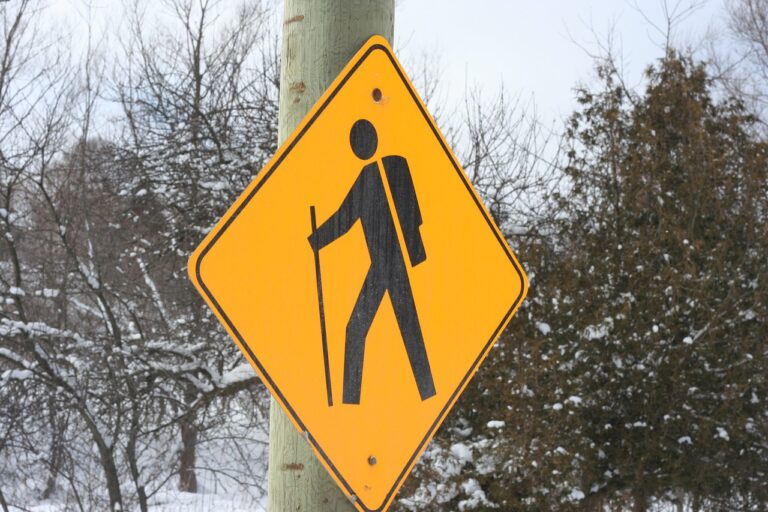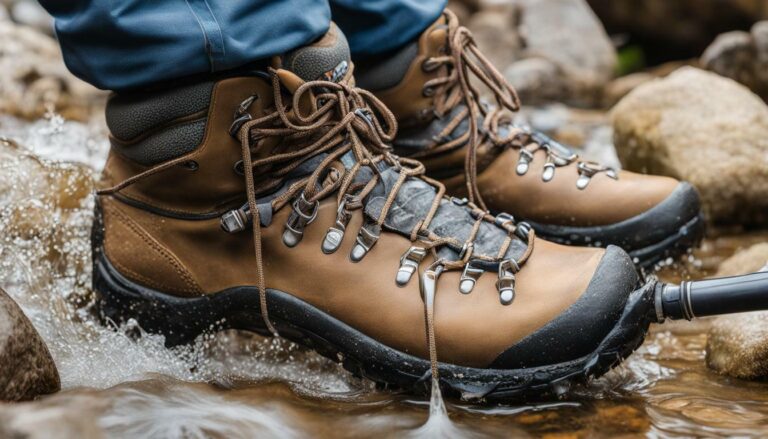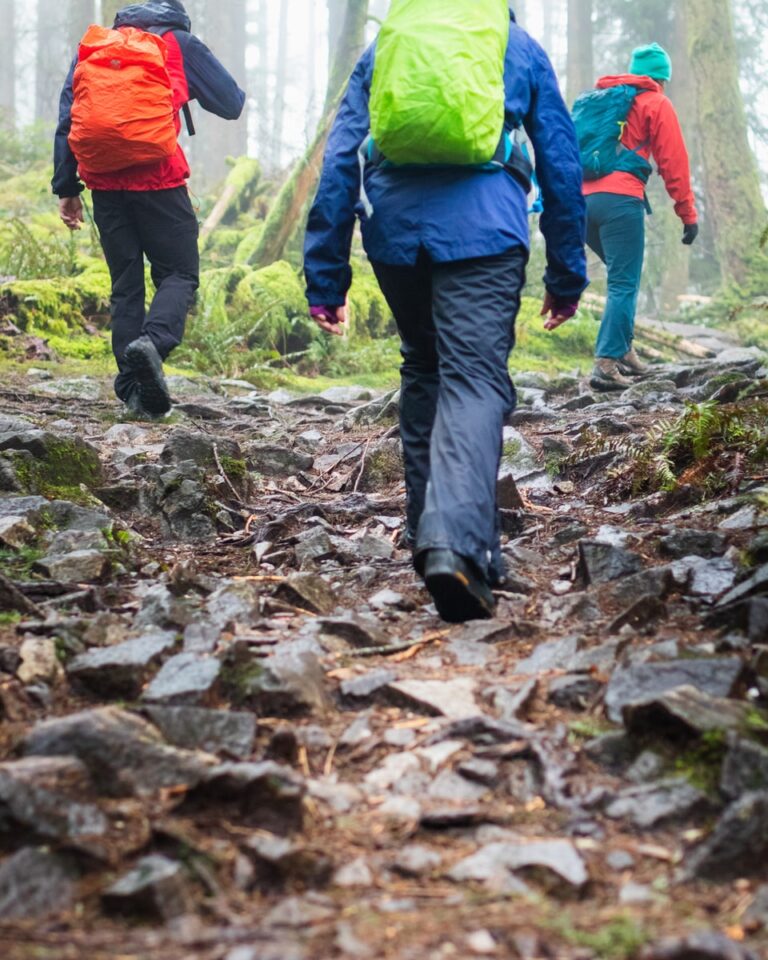Uncover Secrets: How to Choose the Right Hiking Shoes

Choosing the right hiking shoes is critical for an enjoyable and safe hiking experience. Your footwear not only affects your comfort but also your performance and safety. With so many options available, it can be overwhelming to select the perfect pair. That’s why we have created a comprehensive hiking shoe buying guide to help you make an informed decision.
Key Takeaways:
- Choosing the right hiking shoes is crucial for comfort and safety during your outdoor expeditions.
- Our comprehensive hiking shoe buying guide provides an in-depth analysis of the critical factors to consider when selecting the perfect pair.
Understanding the Basics of Hiking Footwear
Hiking footwear selection can be overwhelming with the abundance of options available in the market. However, picking the best hiking shoes requires a basic understanding of the different types of hiking shoes and their intended purposes.
The most common types of hiking shoes include hiking boots, hiking shoes, and trail runners. Hiking boots are sturdy and provide excellent support for challenging hikes and backpacking trips. Hiking shoes are lightweight and ideal for day hikes and less challenging terrain. Trail runners are the lightest of the three and are designed for running on hiking trails.
When picking hiking shoes, it is crucial to consider the terrain and weather conditions expected during the hiking trip. For example, hiking boots with excellent ankle support and waterproofing are best for hiking in wet and slippery conditions.
Tips for Picking the Best Hiking Shoes
- First, determine the type of hiking shoe required based on the intended terrain and weather conditions.
- Ensure an exact fit by trying on hiking shoes with the type of socks that will be worn during the hike.
- Focus on the comfort of the shoe, taking note of areas of potential discomfort such as the toes, heels and arches.
- Consider the weight of the shoe, particularly useful for long hikes and backpacking trips.
- Select shoes with a suitable level of support based on the hiking trail’s difficulty level.
- Lastly, prioritize durability by selecting shoes made from high-quality materials that can withstand rough terrain and the elements.
By taking into consideration the above, hikers can select hiking shoes that offer the best fit, comfort, support, durability, and protection based on their personal preferences and hiking needs.
The Importance of Fit and Comfort in Hiking Shoes
When it comes to hiking shoes, finding the right fit and ensuring maximum comfort should be at the top of your priority list. Ill-fitting shoes can lead to a range of foot health problems, from blisters and hotspots to more severe issues like plantar fasciitis and stress fractures.
Assessing fit is crucial when selecting hiking shoes. Begin with the size – it’s important to measure your feet before making a purchase. Remember that hiking shoes should fit snugly but not be too tight. Leave enough room for your toes to move freely and for your feet to swell during extended hikes. Consider the width of the shoe as well, making sure it’s suitable for your foot shape.
Arch support is another important factor to consider for a comfortable fit. Hiking shoes with appropriate arch support can help prevent foot fatigue and pain caused by overpronation or supination. If you have high arches, look for shoes with more cushioning, while those with flat feet should opt for shoes with more stability and support.
Trying on hiking shoes and taking them for a test hike is the best way to ensure a comfortable fit. Many outdoor retailers offer fitting services to help you find the perfect pair.
Evaluating Material and Durability for Longevity
Choosing the right hiking shoe material is crucial for ensuring durability and longevity. The materials used in hiking shoes impact the weight, flexibility, breathability and durability of the shoe. Here are some of the most commonly used materials found in hiking shoes:
| Material | Pros | Cons |
|---|---|---|
| Leather | Durable, Water-resistant, Breathable, Conform to the feet over time | Heavier, Longer break-in period, Require regular maintenance |
| Synthetic | Lightweight, Quick-drying, Durable, Minimal break-in period | Less breathable, Less water-resistant, Less conforming to the feet |
| Mesh | Breathable, Lightweight | Less durable, Less water-resistant, Less protection from elements |
When choosing a material, consider the hiking terrain, weather conditions, and personal preferences. Leather hiking shoes are ideal for rough terrain, cold or wet conditions, and can last for years with proper care. Synthetic hiking shoes are best suited for hot and dry conditions and offer a good balance between durability and breathability. Mesh hiking shoes are perfect for hot weather and light hiking.
It’s important to note that the quality of the materials used in manufacturing hiking shoes can also impact their durability. Look for high-quality materials that are designed to withstand the wear and tear of hiking. You want a pair of hiking shoes that can last for years, not just a few hikes.
By carefully evaluating the materials used in hiking shoes, you can ensure that you are choosing high-quality and durable footwear that will keep your feet safe and comfortable for years to come.
Traction and Grip: Ensuring Stability on Challenging Terrains
When it comes to hiking shoes, traction and grip are crucial for ensuring stability on challenging terrains. The right kind of traction ensures that you keep your footing and maintain balance when walking on rough terrain. Moreover, grip plays an important role in keeping your footing secure on wet and slippery surfaces.
The outsole of a hiking shoe largely determines its traction and grip. When selecting hiking shoes, look for outsoles with deep lugs or treads that provide adequate grip on various terrains. Additionally, consider the materials used in the outsole, as some materials offer better grip and durability than others. Vibram soles are a good example of high-quality materials that are known for providing exceptional traction and durability.
It’s important to select hiking shoes with the right tread pattern for the terrain you’ll be hiking on. For example, hiking on rocky terrain requires shoes with a more aggressive tread pattern to provide better grip and traction. On the other hand, hiking on muddy or wet trails requires shoes with a wider and deeper tread pattern.
If you’re planning on hiking in a particular season or climate, make sure to select hiking shoes that are appropriate for those conditions. Shoes with directional lugs are great for hiking on snowy and icy trails, as they provide better traction on these surfaces. Additionally, shoes with waterproofing technology like Gore-Tex can be beneficial for hiking in wet weather conditions.
Another important factor to consider when selecting hiking shoes is the weight of the shoes. Heavier shoes can provide better traction and stability, but they can also be more cumbersome and uncomfortable to wear for extended periods. On the other hand, lighter shoes may not offer as much traction and stability, but they are more comfortable and less restrictive.
Overall, selecting hiking shoes with good traction and grip is essential for ensuring a safe and comfortable hiking experience. By considering the terrain, climate, and your personal preferences, you can choose the right hiking shoes that provide you with the support and stability you need.
The Importance of Support and Stability in Hiking Shoes
When it comes to hiking shoes, support and stability are crucial factors to consider. Without adequate support, your feet can suffer from fatigue and discomfort, and you might even risk injuries on challenging terrains. Therefore, it’s essential to choose hiking shoes that provide ample support and stability.
One critical feature to look for in hiking shoes is ankle support. Ankle injuries are common when hiking on challenging terrain, and proper ankle support can prevent such injuries. Look for hiking shoes with a high collar that can support your ankles and prevent them from rolling over.
The midsole stiffness is another important aspect of hiking shoes that contributes to support and stability. A stiffer midsole provides more support and reduces foot fatigue, while a softer midsole offers more flexibility and comfort. Consider the nature of your hikes and your preferences before selecting the appropriate midsole stiffness for your hiking shoes.
Heel counters, which are stiff materials that wrap around the heel area, are also crucial in providing support and stability. They keep your heel in place and prevent it from slipping out of the shoe. Therefore, it is advisable to look for hiking shoes with a sturdy heel counter.
Remember, choosing hiking shoes with adequate support and stability can prevent injuries, increase your performance, and enhance your overall hiking experience. So, take your time to assess your needs and preferences and select hiking shoes that provide the right level of support for your feet.
Finding the Right Style and Aesthetics for Hiking Shoes
When it comes to hiking shoes, functionality and features should be the top priority. But let’s be real, we all want our shoes to look good too! Luckily, there are various designs, colors, and styles available to cater to personal preferences.
Whether you prefer a classic look or want to make a statement on the trails, there is a hiking shoe out there for you. Some popular styles include low-cut, mid-cut, and high-cut shoes. A low-cut shoe offers more flexibility and breathability, while a high-cut shoe provides more ankle support and stability. A mid-cut shoe is a happy medium between the two.
Color options also vary, with many brands offering earthy tones that blend into the natural surroundings. However, if you want to stand out, there are also brighter colors and patterns available.
While style and aesthetics are undoubtedly important, it is essential to prioritize the features that contribute to a comfortable and safe hiking experience. Ensure the hiking shoe fits well, provides adequate support, and has a durable outsole for superior traction. With those factors in mind, you can find a hiking shoe that not only looks great but performs exceptionally.
Putting It All Together: A Comprehensive Guide to Choosing Hiking Shoes
Choosing the right hiking shoes is essential for a comfortable and safe outdoor experience. Here is a comprehensive guide to help you make an informed decision.
- Assess Your Needs: Consider the type of hiking you will be doing, as well as the terrain, climate, and duration of your hikes. This will help you determine the level of support, durability, and traction you need in your hiking shoes.
- Focus on Fit: Proper fit is crucial for comfort and preventing injuries. Ensure your hiking shoes are the right size and width for your feet and provide adequate arch support. Consider trying on different brands and styles to find the best fit.
- Comfort is Key: Look for hiking shoes with ample cushioning, breathable materials, and a flexible design that conforms to your foot’s natural movement. Remember, your hiking shoes should feel comfortable right out of the box.
- Evaluate Material and Durability: Select materials that best suit your hiking conditions and climate. Keep in mind that more durable materials tend to be heavier, while lightweight materials may sacrifice durability. Decide what is most important to you and your hiking needs.
- Consider Traction and Stability: Choose hiking shoes with adequate traction and grip for the terrain you will be hiking on. Look for a design that provides stability and support, such as ankle support and a stiff midsole.
- Find the Right Style: Hiking shoes come in various designs, colors, and styles. While aesthetics are important, prioritize functionality and features over style. Choose a style that aligns with your hiking needs and preferences.
- Test Them Out: Once you have selected a pair of hiking shoes, test them out on a short hike or walk around your neighborhood to ensure they are comfortable and provide the necessary support and traction you need.
By following these guidelines, you can feel confident in choosing the right hiking shoes for your next adventure. Remember, comfort and safety should be your top priorities when selecting hiking footwear. Happy trails!
The Comprehensive Guide to Choosing the Right Hiking Shoes
Choosing the perfect pair of hiking shoes can be daunting, but it doesn’t have to be. By following these simple steps, you can find the right shoes to make your hiking experience safe and comfortable.
Step 1: Determine Your Needs
Consider the type of trail you’ll be hiking, the climate you’ll be in, and the length of your hike. These factors will help you determine what features your shoes should have.
Step 2: Assess Fit and Comfort
Make sure your shoes fit properly and are comfortable. Your hiking shoes should feel snug but not tight. Check for sufficient arch support, cushioning, and breathability.
Step 3: Evaluate Material and Durability
Choose a material that suits your needs and preferences. Leather shoes are durable and provide good support, while synthetic materials are lightweight and breathable. Make sure your shoes are also durable enough to withstand the terrain you’ll be hiking on.
Step 4: Consider Traction and Grip
Choose shoes with a patterned sole and deep, sturdy lugs for superior traction. Depending on the trail you’ll be hiking, you may need shoes with more or less aggressive tread patterns.
Step 5: Prioritize Support and Stability
Your hiking shoes should provide ample support and stability to prevent injuries. Look for shoes with good ankle support, a stiff midsole, and a reinforced heel counter.
Step 6: Balance Style and Functionality
While aesthetics are important, prioritize functionality and features over style when choosing your hiking shoes. Make sure your shoes are appropriate for the trail you’ll be hiking on.
Step 7: Put It All Together
Consider all of these factors together when choosing your hiking shoes. Take your time, try several pairs on, and don’t be afraid to ask for advice. With the right pair of shoes, you’ll be able to enjoy your hiking experience to the fullest.
Conclusion
Choosing the right hiking shoes can make all the difference in your outdoor experience. By following these simple steps, you’ll be equipped with the knowledge to choose the perfect pair. Remember to prioritize fit, comfort, traction, support, and durability, and don’t forget to balance style with functionality. Good luck, and happy hiking!
FAQ
Q: Are hiking shoes different from regular sneakers?
A: Yes, hiking shoes are specifically designed for outdoor activities and offer better support, traction, and durability compared to regular sneakers.
Q: How do I determine the right size for hiking shoes?
A: It is recommended to measure your feet using a foot measuring device and refer to the sizing chart provided by the brand. Trying on the shoes and ensuring a thumb’s width of space in the toe box is also important for a proper fit.
Q: What features should I look for in hiking shoes for different terrains?
A: For rocky terrains, look for shoes with a protective toe cap and sturdy outsoles. For muddy terrains, choose shoes with deep lugs and good grip. Waterproofing is essential for wet conditions, and breathable materials are preferable for hot weather.
Q: How often should I replace my hiking shoes?
A: The lifespan of hiking shoes depends on factors such as usage, terrain, and care. As a general guideline, it is recommended to replace hiking shoes every 500-800 miles or when signs of wear and tear, reduced cushioning, or lack of support become apparent.
Q: Can I use hiking shoes for other outdoor activities?
A: Yes, hiking shoes can be used for various outdoor activities such as trail running, backpacking, or light hiking. However, for specialized activities like mountaineering or long-distance backpacking, it is advisable to choose footwear specifically designed for those purposes.
Q: How can I break in new hiking shoes?
A: To break in new hiking shoes, wear them gradually for short hikes or walks in different terrains. It is important to listen to your feet and not push through excessive discomfort. Applying a waterproofing treatment or using specialized shoe stretching techniques can also help improve comfort.






